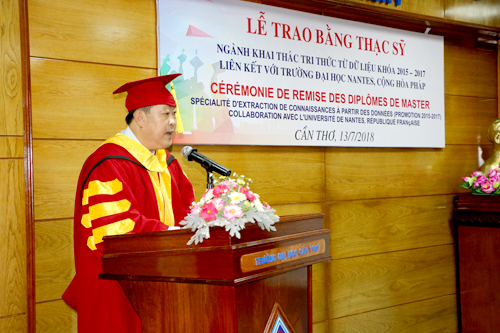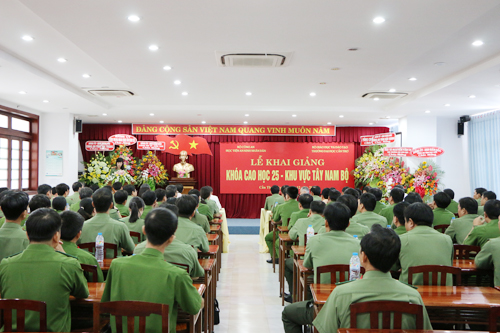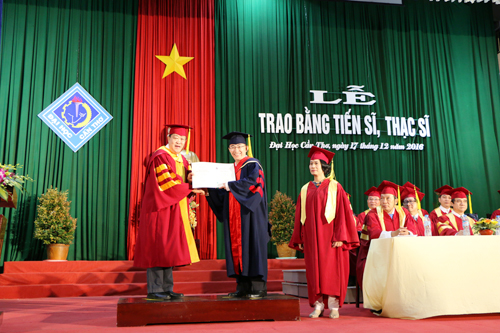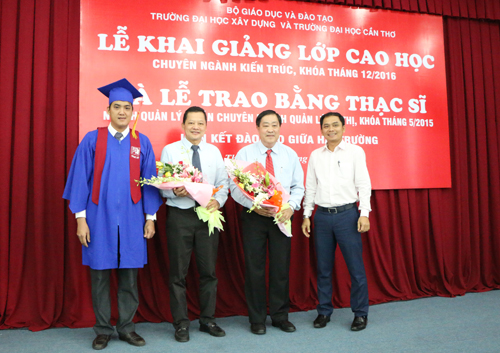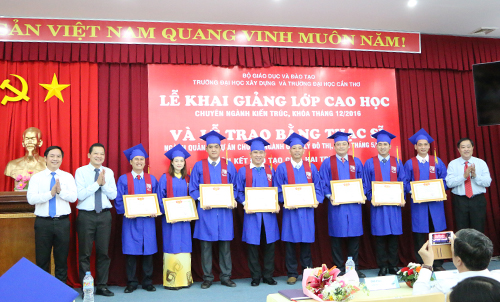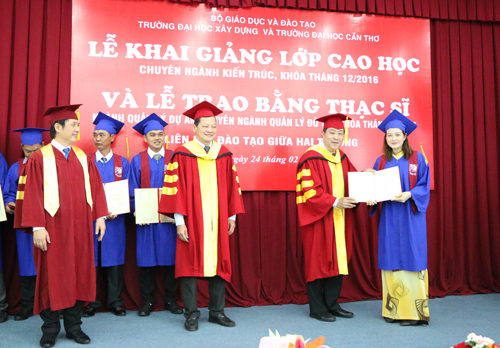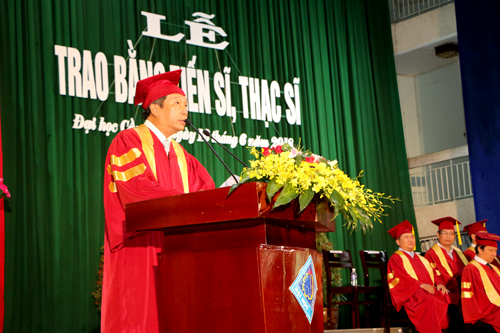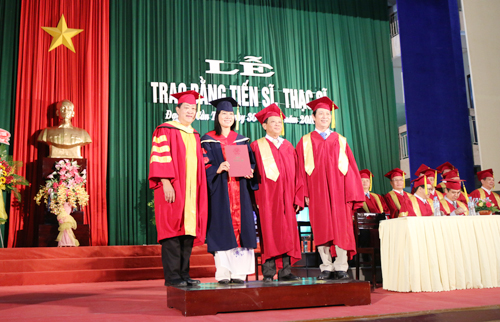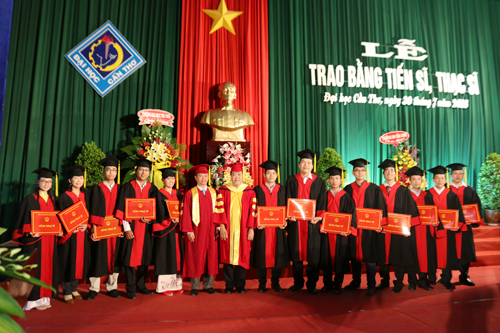
 Tên đề tài: “Nghiên cứu trích ly polyphenol từ củ hà thủ ô đỏ (Polygonum multiflorum Thunb.) và ứng dụng trong thực phẩm ”.
Tên đề tài: “Nghiên cứu trích ly polyphenol từ củ hà thủ ô đỏ (Polygonum multiflorum Thunb.) và ứng dụng trong thực phẩm ”.
 Tác giả: Lê Phạm Tấn Quốc, Khóa: 2014
Tác giả: Lê Phạm Tấn Quốc, Khóa: 2014
 Chuyên ngành: Công nghệ thực phẩm; Mã số: 62540101. Nhóm ngành: Công nghệ sản xuất và chế biến
Chuyên ngành: Công nghệ thực phẩm; Mã số: 62540101. Nhóm ngành: Công nghệ sản xuất và chế biến
 Người hướng dẫn chính: PGS.TS. Nguyễn Văn Mười, Trường Đại học Cần Thơ.
Người hướng dẫn chính: PGS.TS. Nguyễn Văn Mười, Trường Đại học Cần Thơ.
- Tóm tắt nội dung luận án:
Luận án nghiên cứu một số phương thức bảo quản có ảnh hưởng đến sự ổn định hàm lượng và hoạt tính polyphenol trong củ hà thủ ô đỏ như bảo quản lạnh đông hà thủ ô tươi xắt lát, khảo sát chế độ sấy hà thủ ô xắt lát, bảo quản hà thủ ô dạng bột ở nhiệt độ phòng. Kết quả khảo sát cho thấy hàm lượng và hoạt tính polyphenol đều suy giảm theo thời gian bảo quản. Tuy nhiên, tiến hành lạnh đông nhanh củ tươi xắt lát trước khi trữ đông có thể duy trì sự ổn định polyphenol tốt hơn lạnh đông chậm sau 180 ngày bảo quản. Trong khi đó, sấy củ xắt lát ở điều kiện 60oC trong 210 phút duy trì hàm lượng và hoạt tính polyphenol cao hơn các nhiệt độ khác. Đối với mẫu bột khô, hàm lượng và hoạt tính polyphenol có thể duy trì ổn định trong 60 ngày và sau 100 ngày bảo quản hàm lượng giảm 13% và hoạt tính giảm 6%.
Sử dụng các phương pháp trích ly khác nhau như ngâm chiết hoàn lưu, trích ly có hỗ trợ vi sóng, siêu âm nhằm tìm ra phương pháp trích ly tối ưu với điều kiện thích hợp để có được hàm lượng và hoạt tính polyphenol cao nhất. Kết quả tối ưu hóa bằng bề mặt đáp ứng đối với quá trình trích ly cho thấy phương pháp trích ly có hỗ trợ vi sóng đạt hiệu quả cao nhất ở điều kiện công suất 127 W/g, thời gian trích 4,82 phút, tỉ lệ nguyên liệu/dung môi 1/39,98 (g/mL) và nồng độ dung môi acetone là 57,35%, hàm lượng và hoạt tính polyphenol tối ưu lần lượt là 47,53±0,79 (mg GAE/g CK) và 334,07±3,04 (µmol TE/g CK).
Polyphenol trong dịch chiết thu nhận được ở điều kiện tối ứu có khả năng tương tác và làm kết tủa protein (gelatin). Ngoài ra, cao chiết còn kháng được một số vi sinh vật như Salmonella enteritidis, Staphylococcus aureus và Trichoderma asperellum khi xác định nồng độ ức chế tối thiểu bằng phương pháp khuếch tán đĩa giấy. Đồng thời ở nồng độ dịch chiết polyphenol 208 và 415 mg GAE/L có thể duy trì chất lượng đu đủ cắt trong 6 ngày khi bảo quản lạnh và thịt cá diêu hồng nghiền trong 100 ngày khi bảo quản lạnh đông.
Bên cạnh đó, tiến hành sấy phun dịch chiết bằng chất mang là gum arabic và maltodextrin đã xác định được các đặc điểm và tính chất hóa lý của chế phẩm sấy phun. Kết quả cho thấy cả 2 chế phẩm sấy phun có tính chất hóa lý hoàn toàn khác nhau, chế phẩm gum arabic duy trì hiệu suất thu hồi, hàm lượng và hoạt tính polyphenol tốt hơn chế phẩm maltodextrin. Ngoài ra, xây dựng mô hình dự đoán thời gian bảo quản (shelf-life) sự suy thoái polyphenol của dịch chiết và chế phẩm sấy phun theo nhiệt độ đã được thực hiện. Kết quả cũng cho thấy sự suy thoái giữa hàm lượng và hoạt tính của polyphenol không tương đồng nhau trong cùng chế độ bảo quản.
Dịch chiết tại nồng độ ứng dụng trong thực phẩm được tiến hành để đánh giá độc tính cấp và độc tính bán trường diễn. Kết quả cho thấy ở các nồng độ khảo sát không có độc tính cấp và độc tính bán trường diễn trên chuột trong khoảng nồng độ khảo sát.
- Những kết quả mới của luận án:
Đánh giá được sự suy giảm hàm lượng và hoạt tính chống oxi hóa của polyphenol đối với củ hà thủ ô đỏ trong một số phương pháp bảo quản và sơ chế. Đồng thời nghiên cứu quá trình trích ly tối ưu polyphenol từ nguyên liệu này ở Việt Nam được xác lập.
Polyphenol trong dịch chiết có khả năng kháng được một số vi sinh vật và tương tác mạnh mẽ với protein (gelatin).
Ứng dụng nồng độ dịch chiết polyphenol thích hợp để duy trì chất lượng trong quá trình bảo quản lạnh đu đủ cắt và bảo quản lạnh đông thịt cá diêu hồng nghiền.
Tạo ra nguồn chế phẩm vi bao dịch chiết polyphenol bằng gum arabic và maltodextrin. Xây dựng được mô hình dự đoán mức độ suy giảm hàm lượng và hoạt tính polyphenol của dịch chiết và chế phẩm sấy phun theo nhiệt độ bảo quản.
Thử nghiệm dịch chiết polyphenol an toàn, không có độc tính trên mô hình chuột thí nghiệm.
- Các ứng dụng/khả năng ứng dụng trong thực tiễn, các vấn đề cần tiếp tục nghiên cứu:
Sản phẩm dịch chiết và chế phẩm sấy phun rất có tiềm năng ứng dụng trong đời sống, đặc biệt trong công nghệ bảo quản trái cây sau thu hoạch và bảo quản các sản phẩm thịt cá. Tuy nhiên, cần thực hiện một số khảo sát làm cơ sở cho việc phát triển sản phẩm với quy mô công nghiệp, cụ thể như sau:
- Nghiên cứu thêm về một số phương pháp trích ly polyphenol hiện đại hơn như CO2 siêu tới hạn, áp suất cao,… để cải thiện hiệu quả trích ly.
- Nghiên cứu khả năng ứng dụng của chế phẩm sấy phun trong bảo quản và chế biến thực phẩm.
- Nghiên cứu loại hợp chất polyphenol điển hình trong củ hà thủ ô đỏ có thể cô lập, tinh sạch, ứng dụng trong bảo quản và chế biến thực phẩm.
- Abstract:
The thesis studied some storage methods that affect the stable content and antioxidant capacity of polyphenols from Polygonum multiflorum Thunb. root, including freezing method, drying method (for sliced fresh root) and storage of powdered product at room condition. The result showed that the content and antioxidant capacity of polyphenols always degraded during the storage time. However, the quick freezing method could maintain the stability of polyphenols of sliced fresh root after 180 days better than the slow freezing method. Besides, the sliced fresh root dried at 60oC and 210 minutes, which had the maximum content and antioxidant capacity of polyphenols comparing with the other dried conditions. In addition, total polyphenol content and antioxidant capacity of powdered products could maintain stable for 60 days and then decreased by 13% and 6% after 100th days, respectively.
Using some extraction methods including reflux maceration, microwave-assisted extraction and ultrasound-assisted extraction for researching the optimal methods that achieved the best content and antioxidant capacity of polyphenols. The studies showed that the optimization of microwave-assisted extraction of polyphenols by response surface methodology had the best results at a microwave power of 127 W/g, extraction time of 4.82 minutes, material/solvent ratio of 1/39.98 (g/mL) and acetone concentration of 57,35%. The optimal content and antioxidant capacity of polyphenols were 47.53±0.79 (mg GAE/g DW) and 334.07±3.04 (µmol TE/g DW), respectively.
Polyphenols extract at the optimal extraction condition had protein-polyphenol interaction and precipitated protein (gelatin). In addition, dryness extract inhibited some microorganisms such as Salmonella enteritidis, Staphylococcus aureus and Trichoderma asperellum, the minimum inhibitory concentration of microorganism was determined by the paper disc diffusion method. Polyphenols concentrations of 208 and 415 mg GAE/L could maintain the quality of fresh-cut papaya during 6 days at the cold condition and minced red tilapia during 100th days at freezing storage, respectively.
Besides, experiments were performed to spray-drying polyphenols extract with carrier agents such as gum arabic and maltodextrin; analyzed the physical-chemical properties of spray-drying products. The results showed the both of spray-drying products that had absolutely different physical-chemical properties, gum arabic could maintain the yield, total polyphenol content and antioxidant capacity better than maltodextrin. In addition, this study built the model to predict the shelf-life of polyphenols extract and spray-drying products at various storage temperatures. The results showed that the degradation of total polyphenol content and antioxidant capacity that were not similar in the same storage conditions.
Extract concentration at the application of food product was performed to determine the acute and semi-chronic toxicities on mice. The results showed that it is not toxic for mice in researched extract concentration.
- New points:
The degradations of total polyphenol content and antioxidant capacity of Polygonum multiflorum Thunb. root was evaluated in some storage methods and preliminary treatment. In addition, the optimal factors of the polyphenols extraction process from this material were determined.
Polyphenols extract at the optimal extraction condition can inhibit some microorganisms and had a strong protein-polyphenol interaction (gelatin)
Some polyphenols extract concentrations could maintain the quality of fresh-cut papaya for the cold storage method and minced red tilapia for the freezing storage method.
Spray-drying products by gum arabic and maltodextrin were produced. Building the model to predict the shelf-life of polyphenols extract and spray-drying product at various storage temperatures were established.
Polyphenols extract from Polygonum multiflorum Thunb. root was safe, there are not toxic in the experimental mouse model.
- Application/applicability in practice and further studies:
Polyphenols extract and spray-drying products have the potential to be processed on a large scale, especially fruit post-harvest technology and meat/fish product storage. However, some surveys should be conducted as a basis for the development of products that processed on an industrial scale, as follows:
- Study on some modern polyphenols extraction methods such as high-pressure extraction, supercritical carbon dioxide extraction,… to improve the effect of extraction.
- Study on application abilities of spray-drying products in storage and food processing.
- Study on some specific polyphenols in Polygonum multiflorum Thunb. root, they would be separated, purified and applied in storage and food processing.
- Xem chi tiết nội dung luận án
- Xem thông tin đăng tải tại Website Bộ giáo dục và Đào tạo. (Nhập tên NCS vào ô tìm kiếm)





